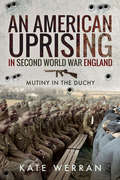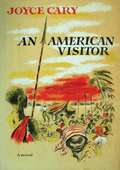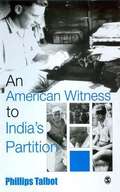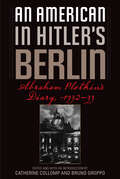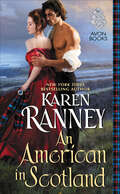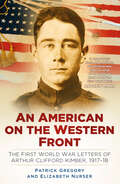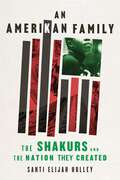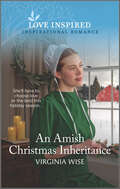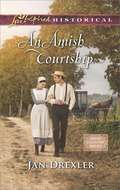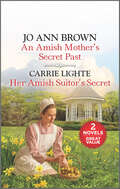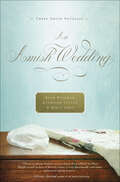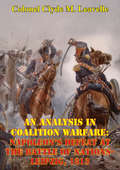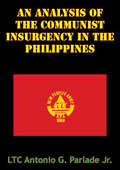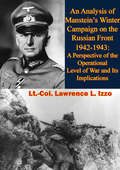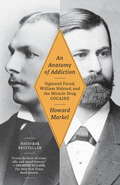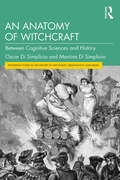- Table View
- List View
An American Uprising in Second World War England: Mutiny in the Duchy
by Kate WerranThe shocking story of a WWII shootout between black and white GIs in a quiet Cornish town that put the British-US “special relationship” on trial.On September 26, 1943, racial tensions between American soldiers stationed in Cornwall erupted in gunfire. Labelled a ‘wild west’ mutiny by the tabloids, it became front page news in Great Britain and the USA. For Americans, it bolstered a fast-accelerating civil rights movement, while in the UK, it exposed unsettling truths about Anglo-American relations. With new archival research, journalist Kate Werran pieces together the shocking drama that authorities tried to hush up. Her narrative examines everything from the controversy of American segregation on British soil to the shocking event itself and the resulting court martial.Extracted from wartime cabinet documents, secret government surveys, opinion polls, diaries, letters and newspapers as well as testimony from those who remember it, this story offers a rare window into a little-known dark side of the ‘American Invasion.’
An American Verdict
by Michael J. ArlenA collection of law cases. In Cook County courthouse, in Room 702, which is Judge Philip Romiti's courtroom, the court is in session.
An American Visitor
by Joyce CaryAn American visitor and uninvited guest in the village of Nok, Marie Hasluck is an irrepressible anthropologist who believes that she has found the Kingdom of Heaven in the forests of Nigeria. There, to her eyes, the Birri tribesmen make love and war unfettered by the constraints and complications of Western civilisation; a state which Marie finds enviable and which she does her best to emulate.However, all is not well even in this pagan paradise: white prospectors are staking claims within Birri territory and the eccentric District Officer, Bewser, can no longer keep them at bay, for all his promises to the villagers. As the Birri warriors become increasingly enraged by the colonialists' betrayal and as her own involvement with Bewser deepens, Marie finds that her position as a charmed but distanced onlooker is inevitably compromised.
An American Witness To India's Partition
by Phillip TalbotIn 1938 the New York-based Institute of Current World Affairs awarded 23-year-old Phillips Talbot a fellowship with a mandate: visit South Asia and learn about the intricacies of life in India. Till 1950, Talbot graphically recounted the buildup to Indian and Pakistani independence, and the early experiences of the new states in the form of several letters to the institute. Talbot`s reports from the field, presented here in the original, offer a kaleidoscope of first-hand observations: on student life at the Aligarh Muslim University, local life in a small Muslim community in Kashmir, a Vedic ashram in Lahore, Tagore`s Shantiniketan, Gandhi's Sevagram, crucial sessions of the Indian National Congress and the All India Muslim League, the Kodaikanal Ashram Fellowship, Hindu and Muslim urban communities in Lahore and Bombay, Afghanistan, a walk with Gandhi in Noakhali, the parties` negotiations with Mountbatten that led to independence and more. Written with flair and insight, An American Witness to India`s Partition, provides a perceptive view of South Asian society in its decisive decade.
An American in Barcelona: Dr. Pearson, The Man Who Brought Light to Catalonia
by Xavier MoretAn inspirational novel of the real-life engineer whose ambitious project to build an electrical grid in Catalonia changed Barcelona forever Xavier Moret illuminates the story of the American engineer Frederick Stark Pearson, an entrepreneur with a global vision, whose innovative business ventures brought electricity to Catalonia. From his arrival in Barcelona in June 1911, Dr. Pearson played a key role in the industrialization of the city, building tram and train networks to benefit from this new form of energy. However, tragedy strikes when Dr. Pearson dies aboard the Lusitania, torpedoed and sunk by a German U-boat. Suddenly, his ambitious project of urban and spatial planning is in jeopardy. Moret compellingly envisions these historic events and the daily life of the American and Spanish pioneers in the local villages and work camps—a world reminiscent of the Wild West. He interweaves this story with his account of his own passionate commitment to chronicling Dr. Pearson&’s remarkable achievements, and how this process of research and discovery ultimately changed his life.
An American in Hitler's Berlin: Abraham Plotkin's Diary, 1932-33
by Abraham PlotkinThis is the first published edition of the diary of Abraham Plotkin, an American labor leader of immigrant Jewish origin who lived in Berlin between November 1932 and May 1933. A firsthand account of the Weimar Republic's final months and the early rise of Nazi power in Germany, Plotkin's diary focuses on the German working class, the labor movement, and the plight of German Jews. Plotkin investigated Berlin's social conditions with the help of German Social-Democratic leaders whose analyses of the situation he records alongside his own. Compared to the writings of other American observers of the Third Reich, Plotkin's diary is unique in style, scope, themes, and time span. Most accounts of Hitler's rise to power emphasize political institutions by focusing on the Nazi party's clashes with other political forces. In contrast, Plotkin is especially attentive to socioeconomic factors, providing an alternative view from the left that stems from his access to key German labor and socialist leaders. Chronologically, the diary reports on the moment when Hitler's seizure of power was not yet inevitable and when leaders on the left still believed in a different outcome of the crisis, but it also includes Plotkin's account of the complete destruction of German labor in May 1933.
An American in Paris
by Margaret Vandenburg&“In the States, celibacy had never been my strong suit. In Paris, it was a crime against nature—a mortal sin.&” With this cheeky response to her new city, Henri Adams—recently released from the tyranny of Prohibition and freshly appointed as an art correspondent for En Vogue magazine—sets out to discover the literary, artistic, and more unmentionable pleasures of Paris during the Roaring Twenties. Welcomed with open arms by Gertrude Stein (and somewhat more soberly by Alice B. Toklas), Henri hobnobs with expatriate luminaries—Natalie Barney, Picasso, Colette, Romaine Brooks, Ernest Hemingway, Djuna Barnes—and unleashes her Yankee curiosity, only to find herself entangled in an avant-garde art theft ring and the shackles of Paris&’ sapphic underground. Gay Paris more than lives up to its name in this prequel to Vandenburg&’s most recent novel, Craze, a Jazz Age portrait of queer New York.
An American in Scotland: A Maclain Novel (The Maciain Series #3)
by Karen RanneyAn American woman sets sail for adventure with a sexy Scot in this historical tale of deceit, desperation & desire by a New York Times–bestselling author.Rose MacIain is a beautiful woman with a secret. Desperate and at her wits’ end, she crafts a fake identity for herself, one that Duncan MacIain will be unable to resist. But she doesn’t realize that posing as the widow of the handsome Scotsman’s cousin is more dangerous than she knew. And when a simmering attraction rises up between them, she begins to regret the whole charade.Duncan is determined to resist the tempting Rose, no matter how much he admires her arresting beauty and headstrong spirit. When he agrees to accompany her on her quest, their desire for each other only burns hotter. The journey tests his resolve as their close quarters fuel the fire that crackles between them.When the truth comes to light, these two stubborn people must put away their pride and along the way discover that their dreams of love are all they need.
An American on the Western Front: The First World War Letters of Arthur Clifford Kimber, 1917-18
by Patrick Gregory Elizabeth NurserThis is the remarkable story of the American First World War serviceman Arthur Clifford Kimber. When his country entered the Great War in 1917, Kimber left Stanford University to carry the first official American flag to the Western Front. Fired by idealism for the French cause, the young student initially acted as a volunteer ambulance driver, before training as a pilot and taking part in dogfights against ‘the Boche’. His letters home give a vivid picture of what Kimber witnessed on his journey from Palo Alto, California to the front in France: keen-eyed descriptions of New York as it prepared for the forthcoming conflict, the privations of wartime Britain and France, and encounters with former president Theodore Roosevelt and Hollywood actress Lillian Gish. Kimber details his exhilaration, his everyday concerns and his horror as he adapts to an active wartime role. Arthur Clifford Kimber was one of the first Americans on the front line after the entry of the US into the war and, tragically, also one of the last to be buried there – killed in action just a few weeks before the end of the war. Here, his frank letters to his mother and brothers, compiled, edited and put in context by Patrick Gregory and Elizabeth Nurser, are published for the first time.
An Amerikan Family: The Shakurs and the Nation They Created
by Santi Elijah HolleyAn Amerikan Family is a light helping us go forward.” — Nikki Giovanni, poetAn enlightening history of the rise and lasting impact of Black liberation groups in America, as seen through the Shakurs, one of the movement’s most prominent and fiercely creative families, home to Tupac and Assata, and a powerful incubator for today’s activism, scholarship, and artistry.They have been celebrated, glorified, and mythologized. They have been hailed as heroes, liberators, and freedom fighters. They have been condemned, pursued, imprisoned, exiled, and killed. But the true and complete story of the Shakur family—one of the most famous names in contemporary Black American history—has never been told.For over fifty years, the Shakurs have inspired generations of activists, scholars, and music fans. Many people are only familiar with Assata Shakur, the popular author and thinker, living for three decades in Cuban exile; or the late rapper Tupac. But the branches of the Shakur family tree extend widely, and the roots reach into the most furtive and hidden depths of the underground.An Amerikan Family is a history of the fight for Black liberation in the United States, as experienced and shaped by the Shakur family. It is the story of hope and betrayal, addiction and murder, persecution and revolution. An Amerikan Family is not only family genealogy; it is the story of Black America’s long struggle for racial justice and the nation’s covert and repressive tactics to defeat that struggle. It is the story of a small but determined community, taking extreme, unconventional, and often perilous measures in the quest for freedom. In short, the story of the Shakurs is the story of America.
An Amish Christmas Inheritance: An Uplifting Inspirational Romance
by Virginia WiseShe wants to settle in for good. But she never expects this holiday hurdle…Inheriting her beloved aunt&’s farm feels like coming home for Katie Schwartz. Unfortunately, it means sharing the farm with handsome—and irritating—Amish widower and daed Levi Miller. Compromise feels almost impossible. But this property isn&’t quite the Christmas gift they expected. Now they&’ll have to work together to save their inheritance…and the love they didn&’t see coming.From Love Inspired: Uplifting stories of faith, forgiveness and hope.
An Amish Christmas Promise and Amish Christmas Hideaway
by Lenora Worth Jo Ann BrownHer Amish holiday heroAn Amish Christmas Promise by Jo Ann BrownCarolyn Wiebe discarded her Amish roots to hide her niece and nephew from their violent father. Yet when a hurricane crashes into their isolated Mennonite life, she can no longer keep the world at bay. With Christmas approaching, Amish carpenter Michael Miller wants to help her rebuild her home. But can their burgeoning love withstand the rising storm of her secrets?Amish Christmas Hideaway by Lenora WorthA festive evening quickly becomes a holiday nightmare when Alisha Braxton witnesses a double murder. And the killer’s cold eyes promise that she’s next. There’s only one person Alisha trusts with her life—private investigator Nathan Craig, the man she once loved. But hiding in Amish country, can they outwit a murderer who’s determined she won’t survive Christmas?New York Times Bestselling Author Lenora Worth
An Amish Courtship
by Jan DrexlerAmish Redemption Samuel Lapp all but accepts his estrangement from the Amish community-until Mary Hochstetter moves in next door to care for her elderly aunt. The young woman with the pretty brown eyes sees Samuel differently than his neighbors do. If he can earn her respect while helping with her aunt's chores, perhaps the rest of the community will follow. But Samuel can't let Mary get too close, lest he disappoint her, as well. Mary's relocation to Shipshewana, Indiana, means confronting her deepest fears. By helping Samuel rebuild his life and his farm, she finally feels ready to embrace her future. But as their delicate friendship grows deeper, they both must overcome their painful pasts before they can build a home together.
An Amish Mother's Secret Past and Her Amish Suitor's Secret
by Jo Ann Brown Carrie LighteSometimes the truth comes at a costAn Amish Mother's Secret Past by Jo Ann BrownWidow Rachel Yoder has a secret: she&’s a military veteran trying to give her children a new life among the Amish. Though she&’s drawn to bachelor Isaac Kauffman, she knows she can&’t tell him the truth—or give him her heart. With her forbidden past, Rachel can never be the perfect Plain wife he&’s looking for… Her Amish Suitor's Secret by Carrie LightePosing as an Amish groundskeeper at Rose Allgyer&’s lakeside cabin retreat, Englischer Caleb Miller is determined to clear his brother&’s name of theft. But as he&’s drawn to Rose&’s good nature, the burden of his ruse gets heavier—especially after learning Rose was deceived by her ex-fiancé. Still guarded, will Rose trust Caleb with her heart when she discovers he isn&’t who he claims to be?
An Amish Wedding: Three Amish Novellas
by Beth Wiseman Kathleen Fuller Kelly LongThree best-selling authors. Three possible brides. Three separate tales. They come together for an Amish wedding.Priscilla King has dreamed of being married to Chester Lapp since she was sixteen. With the help of her sister Naomi’s matchmaking skills, Chester proposes to Priscilla on her nineteenth birthday. As the wedding day approaches, problems emerge: an attendant with poison ivy, a failed celery crop, and a torn wedding dress.At the same time, Priscilla’s best friend Rose is convinced her fiancé is hiding something and she is intent on discovering the truth at any cost.Naomi remains hopeful that she, too, will soon find her perfect match. When Chester’s cousin shows up, there’s an immediate attraction between him and Naomi—as well as an obstacle that may just as immediately derail their blossoming love.Is God sending a message to stop the wedding? What is certain is that the hearts of these three women will be forever transformed by this touching Amish wedding.
An Analysis In Coalition Warfare: Napoleon’s Defeat At The Battle Of Nations-Leipzig, 1813
by Colonel Clyde M. LeavelleRecent history indicates that, in most, if not all, future military conflicts, the United States will participate as part of a coalition. Examination of successful coalitions from the past may reveal precepts which can be applied in order to successfully approach participation in future coalitions. The Battle of Leipzig in 1813 is a superb example of successful coalition operations from early 19th Century. Its detailed study and analysis has led the author to the conclusion that, different principles apply to successful prosecution of coalition operations at each level of war. Understanding and orchestrating the precepts that apply at each level will give the United States the best chance for successful prosecution of its future strategic objectives during war.
An Analysis Of The Communist Insurgency In The Philippines
by Ltc Antonio G. Parlade Jr.The Maoist-inspired Communist Party of the Philippines celebrated its 37th anniversary on December 2005. It marks a long history of violence, terror, and instability in the archipelagic country of 87 million people, causing thousands of casualties among government troops, insurgents, and including civilians. This study seeks to find a lasting solution that will finally bring to a close the final chapter to insurgency in the country. It was approached from a historical point of view by studying the events that lead to the birth of the movement in 1932 until its defeat in 1954. A new chapter of the Maoist insurgency started in 1969 and this movement emerged into a formidable guerrilla force that became the primary threat to the nation's security. This paper tries to analyze how that insurgency persisted to challenge the government this far and what went wrong with the government's response. It will attempt to answer the primary question: How to defeat the communist insurgency?
An Analysis Of The Norwegian Resistance During The Second World War
by Major Kim M. JohnsonThe Norwegian Resistance during the Second World War (April 1940-June 1945) was basically a peaceful set of events conducted by the civilian population as well as underground military organizations. While sabotage and other hostile resistance acts did occur, they were not great in number. It should not be overlooked the Norwegian Armed Forces did fight for 63 days before admitting defeat to Germany.This paper will answer the question "Was the Norwegian Resistance successful against the German Nazis once their country was taken over by them during the Second World War?" The Warden theory of the organization of a system is used to categorize the Resistance movement, dissecting it and placing it in categories. Centers of gravity are noted and discussed. While the Norwegians did not have the military strength to beat the Germans, they did win many battles via their Resistance to the German Rule. These victories along with German acknowledgment prove the Norwegian Resistance was successful against the German Army and its rule over Norway.
An Analysis Of Unit Cohesion In The 42nd Alabama Infantry
by Samuel L. Askew IIIOn 16 May 1862, 904 soldiers formed ranks for the first time and unfurled the virgin colors of the 42nd Alabama Infantry Regiment. These 904 soldiers were a mixture of veterans, volunteers, conscripts, and substitutes. The regiment participated in nine western theater battles and their associated campaigns. These campaigns included Corinth, Vicksburg, Lookout Mountain, Atlanta, and Bentonville. Not one battle was a victory but the heat of battle forged a band of brothers tempered with time. The regiment cased its colors for the last time on 9 April 1865 in a desolate North Carolina field; only ninety-eight soldiers remained at the end of this bloody national struggle. This thesis will identify the timeless factors of cohesion within the 42nd Alabama. This thesis will further determine the most prominent of these factors, specifically within the remaining ninety eight soldiers. Finally, this thesis will explore the value of cohesion to the current military force. This thesis incorporated sources from the The War of the Rebellion: A Compilation of the Official Records of the Union and Confederate Armies, Confederate Veteran, The Southern Historical Papers, personal diaries and letters, census records, compiled service records, sources from the Alabama State Archives and the National Park Service. After the examination of numerous factors, to include discipline, leadership, and morale, the common factor that held the core members of the unit together until the end was the "original volunteer" soldiers of 1861. These soldiers formed the cohesive bond of the unit by instilling a common conviction and devotion to duty within the 42nd Alabama. The final analysis reinforces the value of the volunteer soldier and the worth of an "all-volunteer" force.
An Analysis of Gender and Ethnic Prejudices in Erasmus's Adagia and Other Writings
by Nathan RonThis book explores Erasmus's ethnic and gender prejudices. It does not in any way seek to undermine the esteem in which Erasmus is generally held, as a prince of the humanists; it is rather a consideration of common early modern prejudices. The book&’s principal innovation is the use of Erasmus&’s commentaries on thousands of Greek and Roman proverbs (his adagia) as a source for examining Erasmus&’s worldview. Researchers have often considered the adages as not voicing or reflecting Erasmus&’s views, and as such have chosen to ignore them. However, this book shows that Erasmus occasionally expresses his opinions through the adages, giving us an invaluable window into his worldview. An Analysis of Gender and Ethnic Prejudices in Erasmus's Adagia and Other Writings is essential reading for all scholars and researchers of early modern philosophy and intellectual history especially those researching the thought of Erasmus.
An Analysis of Manstein’s Winter Campaign on the Russian Front 1942-1943: A Perspective of the Operational Level of War and Its Implications
by Lt.-Col. Lawrence L. IzzoThis study is a historical analysis of the campaign waged by Field Marshal von Manstein on the Russian southern front during the winter 1942-43. The study begins just after the 6th Army's encirclement in Stalingrad and describes the four principal phases of Manstein's campaign: the attempted relief of the 6th Army; the protection of Army Group A as it disengaged from the Caucasus; the prevention of Manstein's lines of communications from being cut; and the counterblow to regain the initiative.The lessons learned from the campaign provide a perspective of battle at the operational level of war. The factors leading to Manstein's success are discussed and include: superior generalship at the operational level; superior tactical maturity of the Germans; and German tactical and operational agility. The study describes the transition from the operational defensive to the operational offensive and how a defender can have the initiative. Manstein's use of depth is explained. The concepts of center of gravity and operational art as they pertain to this campaign are also described.The study concludes with the implications of the lessons learned for a NATO-Soviet conflict in a central European scenario. The study points out that Manstein demonstrated that victory is possible even when forced to react to the enemy's plan. The ability of NATO to replicate, today, the agility of Manstein's forces and the synchronization achieved by his commanders is questioned. The implications of NATO's lack of operational depth, in contrast to Manstein, are described. The impact of changes in force design since World War II are also explained.
An Anatomy of Addiction: Sigmund Freud, William Halsted, and the Miracle Drug Cocaine
by Howard MarkelFrom acclaimed medical historian Howard Markel, author of When Germs Travel, the astonishing account of the years-long cocaine use of Sigmund Freud, young, ambitious neurologist, and William Halsted, the equally young, pathfinding surgeon. Markel writes of the physical and emotional damage caused by the then-heralded wonder drug, and how each man ultimately changed the world in spite of it--or because of it. One became the father of psychoanalysis; the other, of modern surgery. Both men were practicing medicine at the same time in the 1880s: Freud at the Vienna General Hospital, Halsted at New York's Bellevue Hospital. Markel writes that Freud began to experiment with cocaine as a way of studying its therapeutic uses--as an antidote for the overprescribed morphine, which had made addicts of so many, and as a treatment for depression. Halsted, an acclaimed surgeon even then, was curious about cocaine's effectiveness as an anesthetic and injected the drug into his arm to prove his theory. Neither Freud nor Halsted, nor their colleagues, had any idea of the drug's potential to dominate and endanger their lives. Addiction as a bona fide medical diagnosis didn't even exist in the elite medical circles they inhabited. In An Anatomy of Addiction, Markel writes about the life and work of each man, showing how each came to know about cocaine; how Freud found that the drug cured his indigestion, dulled his aches, and relieved his depression. The author writes that Freud, after a few months of taking the magical drug, published a treatise on it, Über Coca, in which he described his "most gorgeous excitement." The paper marked a major shift in Freud's work: he turned from studying the anatomy of the brain to exploring the human psyche. Halsted, one of the most revered of American surgeons, became the head of surgery at the newly built Johns Hopkins Hospital and then professor of surgery, the hospital's most exalted position, committing himself repeatedly to Butler Hospital, an insane asylum, to withdraw from his out-of control cocaine use. Halsted invented modern surgery as we know it today: devising new ways to safely invade the body in search of cures and pioneering modern surgical techniques that controlled bleeding and promoted healing. He insisted on thorough hand washing, on scrub-downs and whites for doctors and nurses, on sterility in the operating room--even inventing the surgical glove, which he designed and had the Goodyear Rubber Company make for him--accomplishing all of this as he struggled to conquer his unyielding desire for cocaine. An Anatomy of Addiction tells the tragic and heroic story of each man, accidentally struck down in his prime by an insidious malady: tragic because of the time, relationships, and health cocaine forced each to squander; heroic in the intense battle each man waged to overcome his affliction as he conquered his own world with his visionary healing gifts. Here is the full story, long overlooked, told in its rich historical context.From the Hardcover edition.
An Anatomy of Witchcraft: Between Cognitive Sciences and History (Routledge Studies in the History of Witchcraft, Demonology and Magic)
by Martina Di Simplicio Oscar Di SimplicioMuch has been written on witchcraft by historians, theologians, philosophers, and anthropologists, but nothing by scientists. This book aims to reappraise witchcraft by applying to it the advances in cognitive sciences. The book is divided into four parts. Part I ("Deep History") deals with human emotions and the drive to represent witches as evil female agents. Part II ("Historical Times") focuses on those rare state and church repressions of malefice, which, surprisingly, did not feature in Islamic lands. Modern urbanization dealt a blow to the rural civilizations where accusations of witchcraft were rife. Part III ("In the Laboratory") applies neuroscience to specific case studies to investigate the personification of misfortune, the millenary stereotype witch = woman, the reality of evil, and the phenomenon of treasure hunting. Part IV ("Millenials") wonders whether intentional malefic hatred in a closed chapter in the history of humanity. An Anatomy of Witchcraft is ideal reading for students and scholars. Given its interdisciplinary nature, the book will be of interest to scholars from many fields including evolutionary psychology, anthropology, women’s history, and cognitive sciences.
An Ancient Evil: Disturbing and macabre events in medieval England (Ancient Egypt Trilogy Ser. #1)
by Paul DohertyAs the travellers set out on their pilgrimage, the first tale of death and deceit falls to the Knight...Paul Doherty relates the Knight's tale in An Ancient Evil - a tale of mystery and murder as he goes on pilgrimage from London to Canterbury. Perfect for fans of Ellis Peters and Susanna Gregory.As the travellers gather in the Tabard Inn at the start of a pilgrimage to pray before the blessed bones of St Thomas à Becket in Canterbury, they agree eagerly to host Harry's suggestion of amusing themselves on each day of their journey with one tale, and each evening with another - but the latter to be of mystery, terror and murder.The Knight begins that evening: his tale opens with the destruction of a sinister cult at its stronghold in the wilds of Oxfordshire by Sir Hugo Mortimer during the reign of William the Conqueror, and then moves to Oxford some two hundred years later where strange crimes and terrible murders are being committed. The authorities seem powerless but Lady Constance, Abbess of the Convent of St Anne's, believes the murders are connected with the legends of the cult and she petitions the King for help.As the murders continue unabated, special commissioner Sir Godfrey Evesden and royal clerk Alexander McBain uncover clues that lead to a macabre world sect, which worships the dark lord. But they can find no solution to a series of increasingly baffling questions, and matters are not helped by the growing rift between Sir Godfrey and McBain for the hand and favour of the fair Lady Emily...What readers are saying about Canterbury Tales Mysteries:'Simply one of the best books ever written''An intriguing tale which keeps one entertained up to the last page''Spellbinding'
An Ancient Evil: Disturbing and macabre events in medieval England (Ancient Egypt Trilogy Ser. #1)
by Paul DohertyAs the travellers gather in the Tabard Inn at the start of a pilgrimage to Canterbury, they agree to amuse themselves on each day of their journey with one tale and each evening with another - but the latter to be of mystery, terror and murder. And so begins the Knight's tale. It opens with the destruction of a sinister cult at its stronghold in the wilds of Oxfordshire during the reign of William the Conqueror, and then moves to Oxford some two hundred years later where terrible murders are being committed. The authorities seem powerless but the Abbess of the Convent of St Anne's, believes the murders are connected with the legends of the cult and she petitions the King for help. As the murders continue unabated, special commissioner Sir Godfrey Evesden uncovers clues that lead to a macabre world sect, which worships the dark lord. But he can find no solution to a series of increasingly baffling questions and matters soon worsen...
